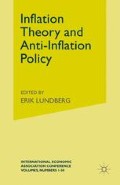Abstract
It may be convenient in a theory of inflation to disregard the influence of the public sector or ‘to assume it away altogether because we have no theory of government expenditure’, as Domar has suggested originally in the context of the theory of economic growth [1] and because our theories of government income hardly go beyond the consequences of techniques used in taxation. But this probably is a more severe restriction for a theory of inflation than for the explanation of almost any other economic phenomenon. Regarding antiinflation policy this would also imply disregarding some of the most important policy instruments. On the contrary, I believe therefore that Schumpeter was right when insisting that fiscal policy and practice were of supreme importance for the development not just of national economies but also of human civilisation and of human behaviour, and that there were only very few exceptions to this rule [2]. Because the public sectors of most industrial economies have grown faster than their G.N.P. during the last decades, this may be even more true today than when Schumpeter wrote his article.
Access this chapter
Tax calculation will be finalised at checkout
Purchases are for personal use only
Preview
Unable to display preview. Download preview PDF.
References
E. Domar, Essays in the Theory of Economic Growth (New York, 1957) p. 20.
J. A. Schumpeter, ‘Die Krise des Steuerstaates’. Zeitfrage aus dem Gebiet der Soziologie, 4. Heft, 1918, quoted from: Aufsätze zur Soziologie (Tübingen, 1953) p. 4.
T. Haavelmo, ‘Multiplier Effects of a Balanced Budget’, Econometrica. Oct. 1945, quoted from: Readings in Fiscal Policy (London, 1955) pp. 335.
J. Hanschel, Kreislauftheorie und Staatschaushalt, Zürich, St. Gallen, 1967, p. 18.
W. A. Salant, ‘Taxes, Income Determination and the Balanced Budget Theorem’. Review of Economics and Statistics, Vol. 39, p. 152 (1957).
R. A. Musgrave, The Theory of Public Finance (New York, 1959), p. 17.
L. Johansen, Public Economics (Amsterdam, London, 1971), p. 3.
A. T. Peacock and J. Wiseman, The Growth of Public Expenditure in the United Kingdom(London, 1967), pp. 37 and 42.
E. Kertzman, ‘The Development of Dutch Public Finance during the Period 1957 – 1969’. Finanzarchiv, N.F., Vol. 31, p. 127 (1972).
R. S. Thorn, ‘The Evolution of Public Finances during Economic Development’, Public Expenditure Analysis, B. S. Sahni (ed.), (Rotterdam, 1972), p. 187.
Beirat für Wirtschafts- und Sozialfragen, Budgetvorschau für das Bundesbudget der Republik Österreich 1974 – 1978 (Wien, 1974), p. 39.
H. C. Adams, The Science of Finance (New York, 1898), chapter 2.
A. Wagner, Finanz Wissenschaft (Leipzig, 1890), 3rd ed., part I, p. 16.
D. Greytak, R. Gustely and R. J. Dinkelmeyer, ‘The Effects of Inflation on Local Government Expenditures’. National Tax Journal, Vol. 27, p. 592 (1974).
J. E. Haring and J. F. Humphrey (eds), Utility Regulation during Inflation (Los Angeles, 1971), p. 13.
F.L. Fernbach, The Increasing Role of Intergovernmental Transfer Payments in the Performance of State and Local Functions. Federal Expenditure Policy for Economic Growth and Stability, Joint Economic Committee, US Government Printing Office (Washington, 1957), pp. 180.
W. L. Smith, Fiscal Policy Issues of the Coming Decade. Materials Submitted to the Subcommittee on Fiscal Policy of the Joint Economic Committee, US Government Printing Office (Washington, 1965), p. 134.
Beirat für Wirtschafts- und Sozialfragen, Empfehlungen zur Budgetpolitik. Vorschläge zur Neuklassifizierung der Transaktionen der öffentlichen Hand (Wien, 1965).
E. S. Phelps (ed), Microeconomic Foundations of Employment and Inflation Theory (New York, 1969).
D. Laidler, ‘Information, Money and the Macroeconomics of Inflation’, Swedish Journal of Economics, Vol. 76 (1974).
P. Davidson and S. Weintraub, ‘Money as Cause and Effect’, Economic Journal,
G. Edgren, K. O. Faxen and C. E. Odhner, ‘Wages, Growth and the Distribution ot Income’. Swedish Journal of Economics, Vol. 71 (1969).
O. Aukrust and I. Prim, A Model of the Price and Income Distribution Mechanism of an Open Economy (Oslo, 1970).
F. Schebeck and H. Suppanz, Ökonometrische Inflationsanalyse für Österreich 1060/1975. Empirica, Vol. 2, p. 180, p. 197 (1974).
J. Werner, ‘Verteilungspolitik — wachstumspolitische und stabilitätspolitische Aspekte’. Beiträge zur Wirtschafts— und Gesellschaftspolitik. Festschrift für Theodor Pütz (Berlin, 1975), pp. 221.
H. Schleicher, Staatshaushalt und Strategie (Berlin, 1971), pp. 22 and 238.
J. S. Duesenberry, Government Expenditures and Growth. Federal Expenditure Policy for Economic Growth and Stability. Joint Economic Committee (Washington, 1957), pp. 289 and 291.
E. D. Domar, Contribution of Federal Expenditures to Economic Growth and Stability. Federal Expenditure Policy. Joint Economic Committee (Washington, 1957), p. 269.
G. Bombach, ‘Möglichkeiten und Grenzen einer Verteilungspolitik. Lohnpolitik und Einkommensverteilung’. Schriften des Vereins für Socialpolitik, N.F., Vol. 51, p. 834 (1969).
W. Fellner, Trends and Cycles in Economic Activity (New York, 1956), pp. 212– 215 and 357 – 367.
E. Matzner, Consequences and Preconditions of Retarded Economic Growth. Institut für Finanzwissenschaft und Infrastrukturpolitik der Technischen Hochschule in Wien, No. 7, pp. 8 – 12 (1975).
Author information
Authors and Affiliations
Editor information
Copyright information
© 1977 International Economic Association
About this chapter
Cite this chapter
Nussbaumer, A. (1977). The Growth of the Public Sector and Inflation Pressure. In: Lundberg, E. (eds) Inflation Theory and Anti-Inflation Policy. International Economic Association Series. Palgrave Macmillan, London. https://doi.org/10.1007/978-1-349-03260-0_14
Download citation
DOI: https://doi.org/10.1007/978-1-349-03260-0_14
Publisher Name: Palgrave Macmillan, London
Print ISBN: 978-1-349-03262-4
Online ISBN: 978-1-349-03260-0
eBook Packages: Palgrave Economics & Finance CollectionEconomics and Finance (R0)

